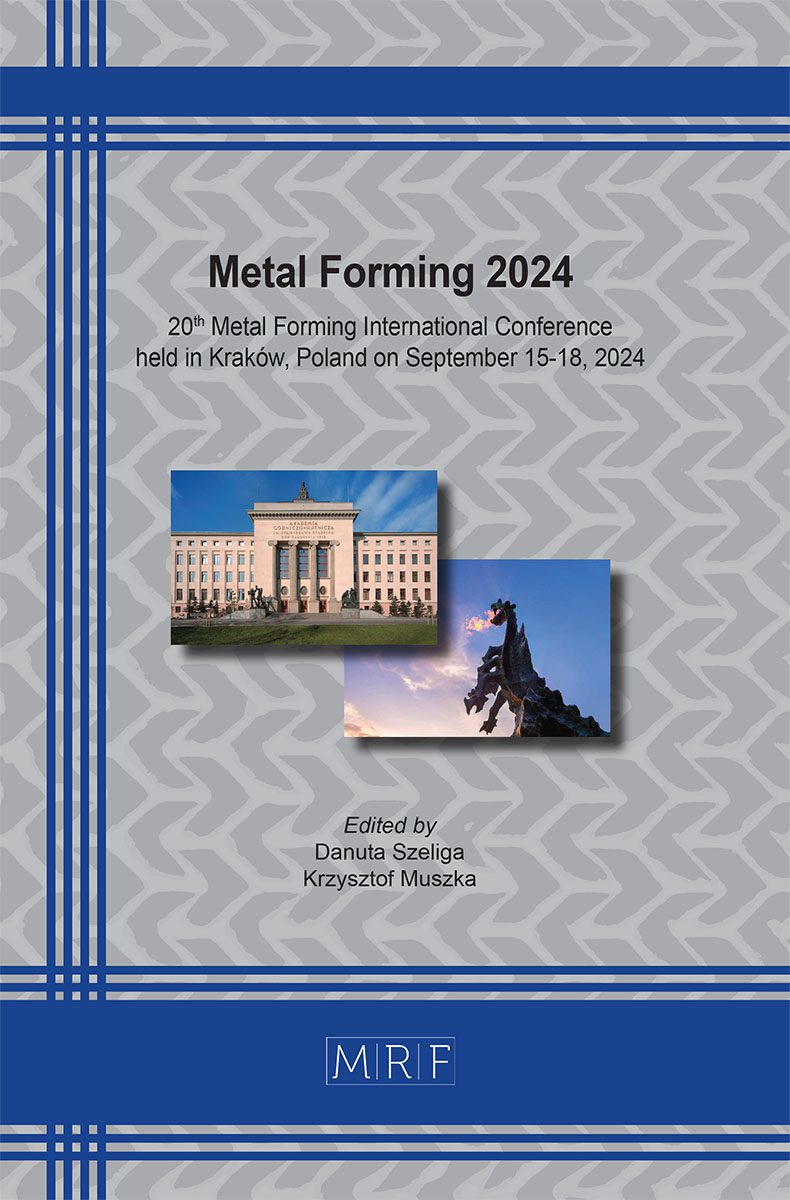–
Effect of surface characteristics on strain distribution in air- bending
KAIJALAINEN Antti, POKKA Aki-Petteri, JASKARI Matias, HUUKI Juha, HINTSALA Tommi, KÖMI Jukka
download PDFAbstract. This study is a continuation of previous studies; therefore, the idea is to determine the influence of surface roughness and hardness on the bendability of a UHSS grade, and it is investigated with 3-point bending tests, utilizing Digital Image Correlation (DIC) for measuring the strain distributions on the outer curvature. Investigated bending samples of a 4 mm thick commercial bainitic-martensitic steel sheet were tested in different surface conditions: (1) as- rolled, (2) dry electropolished, (3) ultrasonic burnishing and (4) a combination of dry electropolishing and ultrasonic burnishing. Ultrasonic burnishing increased the surface hardness and decreased the surface roughness. Bending results showed that smoother surface did not lead to improved bending angles and higher hardness in the subsurface decreased the bending capacity, i.e., reduced the maximum bending angle and critical strain.
Keywords
Roughness, Hardness, Bendability, DIC, Ultra-High Strength Steel
Published online 9/15/2024, 8 pages
Copyright © 2024 by the author(s)
Published under license by Materials Research Forum LLC., Millersville PA, USA
Citation: KAIJALAINEN Antti, POKKA Aki-Petteri, JASKARI Matias, HUUKI Juha, HINTSALA Tommi, KÖMI Jukka, Effect of surface characteristics on strain distribution in air- bending, Materials Research Proceedings, Vol. 44, pp 350-357, 2024
DOI: https://doi.org/10.21741/9781644903254-37
The article was published as article 37 of the book Metal Forming 2024
![]() Content from this work may be used under the terms of the Creative Commons Attribution 3.0 license. Any further distribution of this work must maintain attribution to the author(s) and the title of the work, journal citation and DOI.
Content from this work may be used under the terms of the Creative Commons Attribution 3.0 license. Any further distribution of this work must maintain attribution to the author(s) and the title of the work, journal citation and DOI.
References
[1] SFS-EN ISO 7438, Metallic materials – Bend test, (2016).
[2] A.-P. Pokka, A.-M. Arola, A. Kaijalainen, V. Kesti, and J. Larkiola, Strain distribution during air bending of ultra-high strength steels, ESAFORM 2021, (2021). https://doi.org/10.25518/esaform21.2509
[3] A. Kaijalainen, A.-P. Pokka, M. Jaskari, and J. Kömi, Effect of surface roughness on strain distribution during bending, IOP Conf. Ser. Mater. Sci. Eng., 1270 (2022) 012080. https://doi.org/10.1088/1757-899x/1270/1/012080
[4] M. Kaupper and M. Merklein, Bendability of advanced high strength steels—A new evaluation procedure, CIRP Ann. Manuf. Technol., 62 (2013) 247–250. https://doi.org/10.1016/j.cirp.2013.03.049
[5] K. Cheong, C. Butcher, and J. Dykeman, The influence of the through-thickness strain gradients on the fracture characterization of advanced high-strength steels, SAE Int. J. Mater. Manuf., 11 (2018) 2018-01–0627. https://doi.org/10.4271/2018-01-0627
[6] A.-M. Arola, A. Kaijalainen, and V. Kesti, The effect of surface layer properties on bendability of ultra-high strength steel, AIP Conf. Proc., 1769 (2016) 200024. https://doi.org/10.1063/1.4963642
[7] A. J. Kaijalainen, P. P. Suikkanen, L. P. Karjalainen, and D. A. Porter, Influence of subsurface microstructure on the bendability of ultrahigh-strength strip steel, Mater. Sci. Eng. A, 654 (2016) 151–160. https://doi.org/10.1016/j.msea.2015.12.030
[8] J. Huuki, R. Ullah R, and E. Fangnon, Effects of ultrasonic burnishing on the surface quality of corrosion-resistant tool steel using a hard-carbon-coated burnishing tool, Mater. Res. Proc., 28 (2023) 1775–1780. https://doi.org/10.21741/9781644902479-192
[9] J. Huuki and S. V. Laakso, Integrity of surfaces finished with ultrasonic burnishing, Proc. Inst. Mech. Eng. B: J. Eng. Manuf., 227 (2013) 45–53. https://doi.org/10.1177/0954405412462805
[10] A. J. Kaijalainen, V. Kesti, J. Heikkala, R. Ruoppa, D. A. Porter, and J. I. Kömi, Bendability of shot blasted ultrahigh-strength steels, Mater. Sci. Forum, 941 (2018) 510–515. https://doi.org/10.4028/www.scientific.net/MSF.941.510












